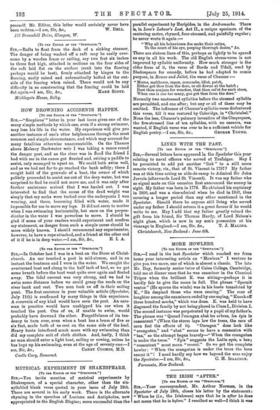[To THE EDITOR 07 TEE " Srmarrros.1
Sin,—Will you allow a few words of comment on your admirable article of last week from a constructor's point of view? With all respect, this question is no longer one for the sole consideration and decision of nautical assessors and paper naval architects, miscalled experts, but rather for the practical shipbuilder of inventive turn. When the 'Titanic' was lost, the writer devised a modification of structural parts of her boat deck, easily fitted between the boats, as then stowed, and the sides of engine and boiler hatches, and form- ing a series of rafts, or pontoons, in themselves of sufficient buoyancy to provide means of safety on either side of the ship for every soul on board. In effect, the top of the pontoons formed portions of the boat deck, level with the top of boiler hatch coamings. The Spectator is not a technical paper, in which the details of this plan (all worked out) could be given. Suffice it to say, they completely meet and answer all Admiral Montagu's objections to rafts, even in such a case as that of the Empress of Ireland.' To show my experience of Board of Trade methods I will enclose two letters received from that Department twenty-three years ago, relating to an invention for boat stowage, insuring instantaneous release from all fastenings by a single move- ment. It was slightly more expensive than the chock-and- grip arrangement accepted by Board of Trade surveyors, so no shipowner would look at it. Application to the Board of Trade by an inventor without political influence or wealth at his back proved useless, and but for the common- sense recommendations of the Canadian Commissioners and yourself, Mr. Editor, this letter would certainly never have







































 Previous page
Previous page